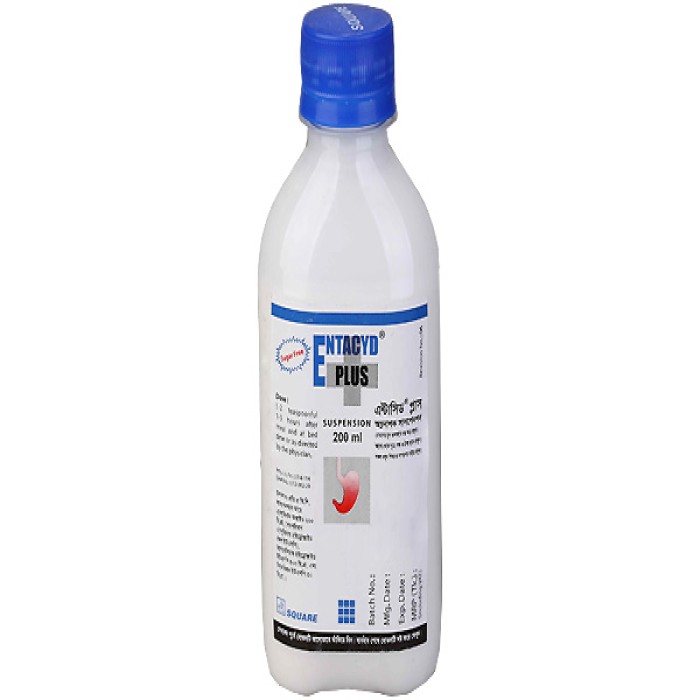accepted your request

Antacyd Plus 200ml Syrup
SkU: 1262
Description
Composition
Each tablet contains-
- Dried Aluminium Hydroxide Gel BP (Al2O3, 47% minimum): 425.53 mg
- Magnesium Hydroxide BP: 400 mg
- Simethicone USP: 30 mg
Each 5 ml contains-
- Aluminium Oxide (Equivalent amount of Aluminium Hydroxide Gel USP): 200 mg
- Magnesium Hydroxide (Equivalent amount of Magnesium Hydroxide Paste USP): 400 mg
- Simethicone USP: 30 mg
Indications
This is indicated for symptomatic relief of hyperacidity associated with the peptic ulcer, gastritis, peptic oesophagitis, gastric hyperacidity, heartburn, sour stomach or hiatus hernia. It is effective in the prevention of stress ulceration and GI bleeding. It acts as an antiflatulent to alleviate the symptoms of gas including post operative gas pain. This rapidly relieves acid pain, disperses gastric foam and facilitates eructation of gas and air.
Therapeutic Class
Antacids
Pharmacology
This is the mixture of non-systemic acid neutralizing substances and antiflatulent. This preparation offers reliability as well as long action. Aluminium Hydroxide and Magnesium Hydroxide induce the relief of ulcer by neutralizing gastric acid secreted from parietal cells of the stomach. The clinical use of simethicone is based on its antifoam properties. Simethicone spreads on the surface of aqueous liquids, forming a film of low surface tension and causing collapse of foam bubbles. Simethicone repeatedly allows mucous surrounded gas bubbles in the GI tract to coalesce and be expelled.
This is used in the treatment of flatulence and meteorism for the elimination of gas, air or foam from the gastro-intestinal tract prior to radiography and for the relief of abdominal distension and dyspepsia.
Simethicone is physiologically inert; it does not appeared to be absorbed from the GI tract to interfere with gastric secretion or absorption of nutrients. Following oral administration, the drug is excreted unchanged in the feces.
Dosage & Administration
Tablet: 1-2 tablets 1-3 hours after meal and at bed time or as directed by the physician.
Suspension: 1-2 teaspoonful 1-3 hours after meal and at bedtime or as directed by the physician.
Interaction
All antacids may increase or decrease the rate and/or extent of absorption of concomitantly administered oral drugs. Antacids decrease the bioavailability of theophyline, tetracycline, quinolone antibiotics, isoniazide, ketoconazole, ethambutol, some antimuscarinic drugs, benzodiazepines, phenothiazines, ranitidine, indomethacine, nitrofurantoin, fluoride, phosphate, propanolol, atenolol, digoxins, vitamins etc. Antacids increase the bioavailability of some drugs; e.g. sulphonamides, levodopa, valproic acid, enteric coated aspirin etc.
Contraindications
This should not be administered in patients with renal failure or hypophosphataemia or in those who are severely debilitated. It is also contraindicated in alkalosis and hypermagnesaemia, where abdominal distention may be due to partial or complete intestinal obstruction.
Side Effects
Gastrointestinal side effects are uncommon. Occasionally, if excessive amount is consumed, diarrhea, constipation or regurgitation may occur.
Pregnancy & Lactation
It is advised to avoid antacid preparations in the first trimester of pregnancy.
Precautions & Warnings
This should be used with caution in patients with kidney disease.
Storage Conditions
Keep below 30°C temperature, away from light & moisture. Keep out of the reach of children.
Reviews
Composition
Each tablet contains-
- Dried Aluminium Hydroxide Gel BP (Al2O3, 47% minimum): 425.53 mg
- Magnesium Hydroxide BP: 400 mg
- Simethicone USP: 30 mg
Each 5 ml contains-
- Aluminium Oxide (Equivalent amount of Aluminium Hydroxide Gel USP): 200 mg
- Magnesium Hydroxide (Equivalent amount of Magnesium Hydroxide Paste USP): 400 mg
- Simethicone USP: 30 mg
Indications
This is indicated for symptomatic relief of hyperacidity associated with the peptic ulcer, gastritis, peptic oesophagitis, gastric hyperacidity, heartburn, sour stomach or hiatus hernia. It is effective in the prevention of stress ulceration and GI bleeding. It acts as an antiflatulent to alleviate the symptoms of gas including post operative gas pain. This rapidly relieves acid pain, disperses gastric foam and facilitates eructation of gas and air.
Therapeutic Class
Antacids
Pharmacology
This is the mixture of non-systemic acid neutralizing substances and antiflatulent. This preparation offers reliability as well as long action. Aluminium Hydroxide and Magnesium Hydroxide induce the relief of ulcer by neutralizing gastric acid secreted from parietal cells of the stomach. The clinical use of simethicone is based on its antifoam properties. Simethicone spreads on the surface of aqueous liquids, forming a film of low surface tension and causing collapse of foam bubbles. Simethicone repeatedly allows mucous surrounded gas bubbles in the GI tract to coalesce and be expelled.
This is used in the treatment of flatulence and meteorism for the elimination of gas, air or foam from the gastro-intestinal tract prior to radiography and for the relief of abdominal distension and dyspepsia.
Simethicone is physiologically inert; it does not appeared to be absorbed from the GI tract to interfere with gastric secretion or absorption of nutrients. Following oral administration, the drug is excreted unchanged in the feces.
Dosage & Administration
Tablet: 1-2 tablets 1-3 hours after meal and at bed time or as directed by the physician.
Suspension: 1-2 teaspoonful 1-3 hours after meal and at bedtime or as directed by the physician.
Interaction
All antacids may increase or decrease the rate and/or extent of absorption of concomitantly administered oral drugs. Antacids decrease the bioavailability of theophyline, tetracycline, quinolone antibiotics, isoniazide, ketoconazole, ethambutol, some antimuscarinic drugs, benzodiazepines, phenothiazines, ranitidine, indomethacine, nitrofurantoin, fluoride, phosphate, propanolol, atenolol, digoxins, vitamins etc. Antacids increase the bioavailability of some drugs; e.g. sulphonamides, levodopa, valproic acid, enteric coated aspirin etc.
Contraindications
This should not be administered in patients with renal failure or hypophosphataemia or in those who are severely debilitated. It is also contraindicated in alkalosis and hypermagnesaemia, where abdominal distention may be due to partial or complete intestinal obstruction.
Side Effects
Gastrointestinal side effects are uncommon. Occasionally, if excessive amount is consumed, diarrhea, constipation or regurgitation may occur.
Pregnancy & Lactation
It is advised to avoid antacid preparations in the first trimester of pregnancy.
Precautions & Warnings
This should be used with caution in patients with kidney disease.
Storage Conditions
Keep below 30°C temperature, away from light & moisture. Keep out of the reach of children.
Store Location: Mirpur
Home Delivery: 30 TK
Delivery Time: Around 06 hours
Cash On Delivery Available
Warranty:
View Cart

